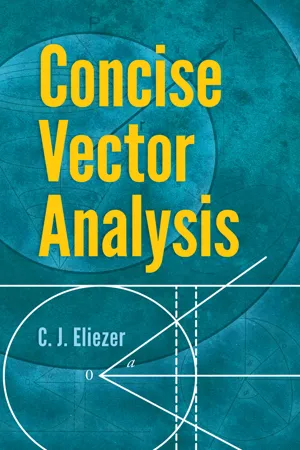
- 160 pages
- English
- ePUB (mobile friendly)
- Available on iOS & Android
eBook - ePub
Concise Vector Analysis
About this book
This concise introduction to the methods and techniques of vector analysis is suitable for college undergraduates in mathematics as well as students of physics and engineering. Rich in exercises and examples, the straightforward presentation focuses on physical ideas rather than mathematical rigor.
The treatment begins with a chapter on vectors and vector addition, followed by a chapter on products of vector. Two succeeding chapters on vector calculus cover a variety of topics, including functions of a vector; line, surface, and volume integrals; the Laplacian operator, and more. The text concludes with a survey of standard applications, including Poinsot's central axis, Gauss's theorem, gravitational potential, Green's theorems, and other subjects.
The treatment begins with a chapter on vectors and vector addition, followed by a chapter on products of vector. Two succeeding chapters on vector calculus cover a variety of topics, including functions of a vector; line, surface, and volume integrals; the Laplacian operator, and more. The text concludes with a survey of standard applications, including Poinsot's central axis, Gauss's theorem, gravitational potential, Green's theorems, and other subjects.
Frequently asked questions
Yes, you can cancel anytime from the Subscription tab in your account settings on the Perlego website. Your subscription will stay active until the end of your current billing period. Learn how to cancel your subscription.
At the moment all of our mobile-responsive ePub books are available to download via the app. Most of our PDFs are also available to download and we're working on making the final remaining ones downloadable now. Learn more here.
Perlego offers two plans: Essential and Complete
- Essential is ideal for learners and professionals who enjoy exploring a wide range of subjects. Access the Essential Library with 800,000+ trusted titles and best-sellers across business, personal growth, and the humanities. Includes unlimited reading time and Standard Read Aloud voice.
- Complete: Perfect for advanced learners and researchers needing full, unrestricted access. Unlock 1.4M+ books across hundreds of subjects, including academic and specialized titles. The Complete Plan also includes advanced features like Premium Read Aloud and Research Assistant.
We are an online textbook subscription service, where you can get access to an entire online library for less than the price of a single book per month. With over 1 million books across 1000+ topics, we’ve got you covered! Learn more here.
Look out for the read-aloud symbol on your next book to see if you can listen to it. The read-aloud tool reads text aloud for you, highlighting the text as it is being read. You can pause it, speed it up and slow it down. Learn more here.
Yes! You can use the Perlego app on both iOS or Android devices to read anytime, anywhere — even offline. Perfect for commutes or when you’re on the go.
Please note we cannot support devices running on iOS 13 and Android 7 or earlier. Learn more about using the app.
Please note we cannot support devices running on iOS 13 and Android 7 or earlier. Learn more about using the app.
Yes, you can access Concise Vector Analysis by C. J. Eliezer in PDF and/or ePUB format, as well as other popular books in Mathematics & Vector Analysis. We have over one million books available in our catalogue for you to explore.
Information
Chapter 1
Vectors and Vector Addition
1.1.Vectors
MATHEMATICS has played an important part in the advance of science, and mathematical language has become essential for the formulation of the laws of science. Numbers, functions, vectors, tensors, spinors, matrices are examples of mathematical entities which occur in various branches of applied mathematics.
The physical quantities with which we are concerned here may be divided into two groups: (a) scalars, (b) vectors. A scalar requires only its magnitude for its specification. For example, temperature, mass, density, volume and energy are scalars. Vectors require both magnitude and direction for their specification. Force, displacement, velocity, acceleration and momentum are vectors.
Vectors may be classified in different ways. In one elementary classification we have three types of vectors distinguished by their effects :
(i) | Unlocalized or free vector which has magnitude and direction but no particular position associated with it, e.g. the moment of a couple. |
(ii) | Sliding vector or vector localized along a straight line, e.g. force acting on a rigid body (though we speak of a force as acting at a point, by the principle of transmissibility of force, it is the line of action and not the point of application that is needed to specify the force). |
(iii) | Tied vector or vector localized at a point, e.g. electric field. |
In the early part of this book whenever we speak of a vector without stating its classification we mean a free vector. Two vectors of the same magnitude and direction, but acting along parallel lines (or along the same line) will be considered as equal or identical. Thereafter other types of vectors are consi...
Table of contents
- Cover
- Title Page
- Copyright Page
- Contents
- Preface
- Chapter 1. Vectors and Vector Addition
- Chapter 2. Products of Vectors
- Chapter 3. Vector Calculus
- Chapter 4. Vector Calculus (Continued)
- Chapter 5. Some Applications
- Index